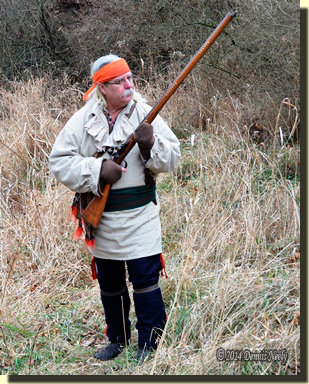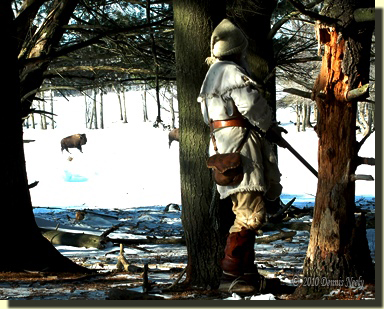Gusty winds swirled ground fog. The air smelled of late March, not November, yet plain and ordinary. Dark clouds delayed first light. A large cedar tree, not eighty paces from Msko-waagosh’s humble wigwam, served as a temporary lair. The mist grew thick, then changed to a light sprinkle. Such was the agony of that sunrise, in the Year of our Lord, 1794.
Bleakness thinned. The mist returned, then subsided. Buffalo-hide moccasins resumed the still-hunt south, up then over the gentle knoll, into the deep valley and around the thick raspberry switches. The returned white captive’s quest ascended a steep west slope. The tight-packed cedar trees hid the swirling black clouds and held back the light drizzle.
Water dripped from bough tips. Red Fox sheltered beneath the easterly lean of a large red oak tree. Gray hairs escaped the confines of the silk head scarf. The warm breeze pushed the rat tails against his cheek and eye lashes, irritating, frustrating. Despite wishing to avoid movement, bare fingers tucked the two offending distractions back under the scarf.

In the midst of the second squall, a foreleg moved, down the hill, amongst the thick underbrush. A deer’s dark sides came and went through the scant spaces. A fox squirrel began a soothing chatter. Antlers appeared, strong and mature, with two broken tines on the animal’s right beam. Msko-waagosh knew this eight-point buck, the one that eluded the Northwest gun’s turtle sight a week earlier.
The sharp flint rose to attention. The tarnished brass butt plate eased to the seasoned hunter’s shoulder. The turtle sight waited as the buck’s hind leg remained planted firm, some eighty paces distant, beyond the smoothbore’s effective distance, but within the range of hope. A gust dislodged one of the rat tails, which blew back and forth against his bunched-up cheek and the trade gun’s battered stock. The squirrel hushed. Rain splattering on soggy oak leaves produced the only sound in the glade.
“A clean kill, or a clean miss. Your will, O Lord,” Msko-waagosh whispered.
The hind leg moved. The returned white captive never glimpsed the buck, never had a shot. He sat with his trade gun up and ready until his arm ached. The forestock balanced on his left knee; his right arm settled into his lap. Fingers tingled as he waited out a buck’s cautious nature. Dark clouds brought a distinct chill. The first November snow began mid-afternoon, by nightfall Msko-waagosh’s buffalo-hide moccasins left clear tracks back to his wigwam, sequestered in the tiny hollow in the hardwoods…
Missing a Moose?
Memoir passages often carry multiple messages. I quoted John Tanner in another missive. The first half of the sentence made my point, the second held a thought provoking statement:
“It happened one morning that I went to hunt with only three balls in my pouch, and finding a large buck moose, I fired at him rather hastily, and missed him twice in succession…” (Tanner, 105).
John Tanner was an accomplished hunter, trained by the Odawa and Ojibwe in the ways of the forest, recognized for his game gathering skills by his peers—sometimes with envy and malice. The amount of ammunition carried was the point of the passage, but the second half of the sentences begs the question, “How do you miss a moose?”
Smoothbore hunters know the limitations of their arm and their abilities. For Tanner, round balls were a precious commodity. That day he started out with three balls. Another day he tells of hunting with seven balls, the number that I carry in my pouch:
“…I had but seven balls left, but as there was no trader near, I could not at present get any more. With those seven I killed twenty moose and elk. Often times, in shooting an elk or a moose, the ball does not pass quite through, and may be used again…” (Ibid, 115).
Before the infamous moose hunt, Tanner describes his shooting ability thus:
“We fixed a mark at a distance of one hundred yards, and I shot first, placing my ball nearly in the center. Not one of either party came near me…” (Ibid, 100).
Starvation threatened his band, and as so often happened, John Tanner provided a good portion of the meat.
“All the men who were still able to walk now determined to start after buffalo, which we knew could not then be very near us…We remained behind, and in a short time killed five moose, all the flesh of which being immediately distributed among the suffering women and children, afforded some relief, and checked the progress of death…” (Ibid, 223).
As this passage shows, Tanner knew how to kill moose. His narrative is filled with hunting exploits that usually end with fresh meat for his extended family. Following this incident, the village decided to move on. One of the hunters stayed back so “that his women might dry the skin of the last moose he had killed, so that they might carry it with them to be eaten in case of the failure of all other supplies…” (Ibid, 224).

Tanner and two young men found the herd, “…saw before us the ground black with buffaloes…” (Ibid). The buffalo hunt progresses and results in another subtle admission by Tanner:
“The men having most of them come from a forest country, and having never hunted buffalo before, all failed to kill except myself…
“Next morning, long before the dawn, the women started for the remains of the two buffalo I had killed, and several of the men, most of them having obtained from me some instruction about the part to be aimed at, again went in pursuit of the herds, and this day several of them killed…” (Ibid, 225).
A longstanding hypothesis holds that the journals of the hunter heroes contain stories and tales that are either meant as an explanation of daily life or unique in nature. The missed moose falls into the latter category in that Tanner used his lock screws to bring the animal down. He admits in the passage that he “fired at him rather hastily.” Been there, done that, lived with the guilt that comes with human frailty and poor judgement.
I suspect Tanner’s hunting technique, which often included crawling on the ground to approach game, resulted in the chance to get off a third shot after two misses. Two shots are the most the hired trading post hunter has gotten off at a deer before it began the death run.
In the end, there seems no obvious answer to “How do you miss a moose?” So many stories recounted by our hunter heroes lack a key element or three. The best we can do is smile and sit in awe. Such is the mystique that surrounds the life and times of John Tanner.
Give traditional black powder hunting a try, be safe and may God bless you.


